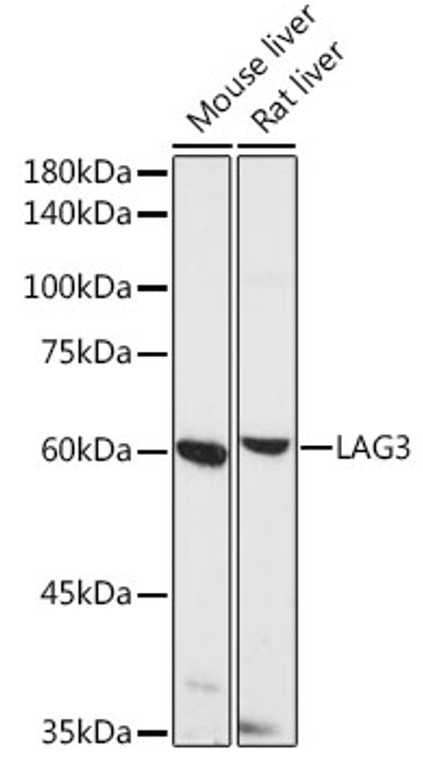| Host: |
Rabbit |
| Applications: |
WB |
| Reactivity: |
Human/Mouse/Rat |
| Note: |
STRICTLY FOR FURTHER SCIENTIFIC RESEARCH USE ONLY (RUO). MUST NOT TO BE USED IN DIAGNOSTIC OR THERAPEUTIC APPLICATIONS. |
| Short Description: |
Rabbit polyclonal antibody anti-LAG3 (29-170) is suitable for use in Western Blot research applications. |
| Clonality: |
Polyclonal |
| Conjugation: |
Unconjugated |
| Isotype: |
IgG |
| Formulation: |
PBS with 0.02% Sodium Azide, 50% Glycerol, pH7.3. |
| Purification: |
Affinity purification |
| Dilution Range: |
WB 1:100-1:500 |
| Storage Instruction: |
Store at-20°C for up to 1 year from the date of receipt, and avoid repeat freeze-thaw cycles. |
| Gene Symbol: |
LAG3 |
| Gene ID: |
3902 |
| Uniprot ID: |
LAG3_HUMAN |
| Immunogen Region: |
29-170 |
| Immunogen: |
Recombinant fusion protein containing a sequence corresponding to amino acids 29-170 of human LAG3 (NP_002277.4). |
| Immunogen Sequence: |
VPVVWAQEGAPAQLPCSPTI PLQDLSLLRRAGVTWQHQPD SGPPAAAPGHPLAPGPHPAA PSSWGPRPRRYTVLSVGPGG LRSGRLPLQPRVQLDERGRQ RGDFSLWLRPARRADAGEYR AAVHLRDRALSCRLRLRLGQ AS |
| Tissue Specificity | Primarily expressed in activated T-cells and a subset of natural killer (NK) cells. |
| Post Translational Modifications | Lymphocyte activation gene 3 protein: Proteolytically cleaved by ADAM10 and ADAM17 within the connecting peptide region, leading to release of Secreted lymphocyte activation gene 3 protein (sLAG-3). ADAM10 mediates constitutive cleavage, but cleavage increases following T-cell activation, whereas shedding by ADAM17 is induced by TCR signaling in a PRKCQ-dependent manner. |
| Function | Lymphocyte activation gene 3 protein: Inhibitory receptor on antigen activated T-cells. Delivers inhibitory signals upon binding to ligands, such as FGL1. FGL1 constitutes a major ligand of LAG3 and is responsible for LAG3 T-cell inhibitory function. Following TCR engagement, LAG3 associates with CD3-TCR in the immunological synapse and directly inhibits T-cell activation. May inhibit antigen-specific T-cell activation in synergy with PDCD1/PD-1, possibly by acting as a coreceptor for PDCD1/PD-1. Negatively regulates the proliferation, activation, effector function and homeostasis of both CD8(+) and CD4(+) T-cells. Also mediates immune tolerance: constitutively expressed on a subset of regulatory T-cells (Tregs) and contributes to their suppressive function. Also acts as a negative regulator of plasmacytoid dendritic cell (pDCs) activation. Binds MHC class II (MHC-II).the precise role of MHC-II-binding is however unclear. Secreted lymphocyte activation gene 3 protein: May function as a ligand for MHC class II (MHC-II) on antigen-presenting cells (APC), promoting APC activation/maturation and driving Th1 immune response. |
| Protein Name | Lymphocyte Activation Gene 3 ProteinLag-3Cd Antigen Cd223 Cleaved Into - Secreted Lymphocyte Activation Gene 3 ProteinSlag-3 |
| Database Links | Reactome: R-HSA-2132295 |
| Cellular Localisation | Lymphocyte Activation Gene 3 Protein: Cell MembraneSingle-Pass Type I Membrane ProteinSecreted Lymphocyte Activation Gene 3 Protein: SecretedProduced Following Cleavage Of The Main Chain |
| Alternative Antibody Names | Anti-Lymphocyte Activation Gene 3 Protein antibodyAnti-Lag-3 antibodyAnti-Cd Antigen Cd223 Cleaved Into - Secreted Lymphocyte Activation Gene 3 Protein antibodyAnti-Slag-3 antibodyAnti-LAG3 antibodyAnti-FDC antibody |
Information sourced from Uniprot.org
12 months for antibodies. 6 months for ELISA Kits. Please see website T&Cs for further guidance







